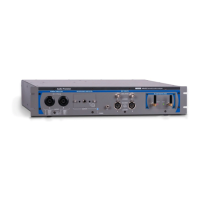Getting Started Guide
APx511 B Series Hearing Instrument Analyzer: Getting Started Guide 43
Calibration
Two main areas are the focus of calibration. The micro-
phone and must be calibrated and the speaker must be lev-
eled for proper measurements to be made.
Microphone Calibration
The microphone may be calibrated with the use of a stan-
dardized calibrator that provides a known level, or entering
the specifications from a microphone data sheet.
The second CalibrateMic function (above) should be used
to set the mic cal value for each signal path in the project,
insuring that all signal paths are properly set up for the
microphone.
Two methods provide status of the calibration by indicating
if a calibration has been performed (by calling
IsMicCalibrated), and the time of the last attempt (by call-
ing MicCalibrationTimestamp). The time of the last calibra-
tion will reflect when it was last performed, regardless of its
success.
Speaker Leveling
The system must determine what levels are required to gen-
erate a flat response through the speaker. This is accom-
plished by performing the leveling. It applies the full range
of frequencies to the speaker and the microphone will cap-
ture the level at that frequency. The resultant table of fre-
quencies and levels can be applied to the APx, so that future
measurements using the speaker will have a flat response
curve.
There is one function for performing this, called
LevelAcousticPath. It takes several arguments. As a result
of a successful leveling, the instrument will be loaded with
the proper equalization table for each measurement used.
Calibration Persistence
Each time the APxHiTest is initialized, it will read in the
calibration and leveling data from previous sessions. If
there has been a change in either the microphone or speaker
parameters, the data will be saved at the close of the
APxHiTest.
Measurements
The supplied functions for performing measurements are
written as such to allow a generalized use, where levels can
be provided based on the needs of the specific test being
performed.
For instance, to measure OSPL90, a call to
MeasureFrequencyResponseLevel is made.
Calibration Technique APXHITest Function Name
Using a calibrator CalibrateMic (calibrator level,
acceptable tolerance)
Using a data sheet CalibrateMic (Signal path,
spec in mV/Pa)
Measuring applied level MeasureCalSPL (signal path,
MeasSplType.ReferenceLevels)
C#.NET
double level = 90.0;
SignalType sweep =
SignalType.FrequencyResponse;
SignalPath path = SignalPath.Acoustic;
APXHiTest.XYarrayPair results = apxHiTest.
MeasureFrequencyResponseLevel(level, path,
sweep);

